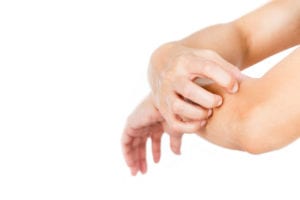Written by Chrystal Moulton, Science Writer. Epidermal water content (SCWC) was significantly increased in both treatment groups compared to control on day 28 (P<0.05).
 Atopic dermatitis is a chronic inflammatory skin disease for which there is no cure. Post diagnosis, the primary treatment goal is symptom alleviation and reducing reoccurrence1. Previous studies have demonstrated the benefits of niacinamide in topical treatments in which niacinamide application improved the function of the stratum corneum2,3. In the current trial researchers assessed the effects of a topical cream and cleansing gel containing niacinamide on clinical symptoms of atopic dermatitis4.
Atopic dermatitis is a chronic inflammatory skin disease for which there is no cure. Post diagnosis, the primary treatment goal is symptom alleviation and reducing reoccurrence1. Previous studies have demonstrated the benefits of niacinamide in topical treatments in which niacinamide application improved the function of the stratum corneum2,3. In the current trial researchers assessed the effects of a topical cream and cleansing gel containing niacinamide on clinical symptoms of atopic dermatitis4.
This study was designed as a randomized, controlled clinical trial. Patients diagnosed with atopic dermatitis were recruited for this trial. Patients were included if they were between the ages of 18 and 65 years old and had mild atopic dermatitis. Patients were excluded from this trial if they suffered from psychiatric diseases or cancer; if they were allergic to excipients or ingredients within the control and experimental treatment used within this study; if they had acute skin lesions; if they were using topical anti-inflammatory, biological agents, glucocorticoids, or PDE4 inhibitors; or if they were, for any reason, unable to complete the trial. Patients were randomly assigned to one of three groups:
- Control group- control cream containing stearic acid, glycerin, and white patrol item the; administered twice daily
- Treatment one- Niacinamide infused cream administered twice daily
- Treatment 2- niacinamide infused cleansing gel (with mannitol and Xylitol) followed by niacinamide infused cream application
Throughout the study, participants in treatment 1 and the control group could only bathe with water. They were not allowed to use soaps or shower gels of any kind. And across all groups, patients were required to use only the treatment protocol provided. All patients were given ebastine tablet orally during the trial due to complaints of pruritus. Researchers evaluated clinical symptoms using the scoring of atopic dermatitis (SCORAD) and peak pruritus numeric rating scale (PP- NRS). Stratum corneum barrier function was evaluated using the Corneometer® which measures water content (SCWC) and trans-epidermal water loss (TEWL). Patient quality of life was assessed using Dermatological Quality of Life Index (DLQI) and Patient Oriented Eczema Measurement (POEM). Patients were assessed on the 0, 7, 14, and 28. Study duration was 4weeks.
122 patients who qualified for and completed this trial were included in the final analysis. On day 7, SCORAD scores was significantly better in T2 compared to both T1 and the control [T2- 15.9 ±3.05 versus T1- 17.9 ±4.04 and control- 17.53 ±4.09, P<0.05]. Compared to the control, researchers observed significant clinical improvement in SCORAD scores on day 28 in both treatment groups [T1- 12.43 ±3.00 and T2- 11.17 ±3.26 versus control 15.1 ±3.64, P<0.05]. In Peak Pruritus Numerical Rating Scale (PP- NRS), researchers observed significant improvement in both treatment groups compared to control on day 14 and 28 (P<0.05). In measures of epidermal barrier function, researchers observed significant decrease in trans-epidermal water loss (TEWL) compared to control on day 28 [T1- 17.4 ±4.82 and T2- 16.10 ±7.30 versus control- 21.2 ±9.47, P<0.05). Epidermal water content (SCWC) was significantly increased in both treatment groups compared to control on day 28 [T1- 67.2 ±21.46 and T2- 69.4 ±24.52 versus control- 52.7 ±22.43, P<0.05]. Furthermore, in both TEWL and SCWC scores, treatment group 2 demonstrated significant improvement compared to both T1 and control on day 14 (P<0.05). In quality-of-life measurements, patients in both treatment groups saw significant improvement in Dermatological Quality of Life Index (DLQI) compared to control on day 14 and day 28 (P<0.05). On day 28, only treatment group 2 has statistically significant improvement in Patient-Oriented Eczema Measure (POEM) compared to control [T2- 5.2 ±1.4 versus control- 6.0 ±1.6, P<0.05].
Overall, results suggest that a topical treatment containing niacinamide significantly improves the quality of life, skin barrier function, and clinical symptoms of atopic dermatitis after four weeks. Further studies will be needed to verify these results.
Source: Zhu, Jun‐Rong, Jie Wang, and Shang‐Shang Wang. “A single‐center, randomized, controlled study on the efficacy of niacinamide‐containing body emollients combined with cleansing gel in the treatment of mild atopic dermatitis.” Skin Research and Technology 29, no. 9 (2023): e13475.
© 2023 The Authors. Skin Research and Technology published by John Wiley & Sons Ltd.
Click here to read the full text study.
Posted April 16, 2024.
Chrystal Moulton BA, PMP, is a 2008 graduate of the University of Illinois at Chicago. She graduated with a bachelor’s in psychology with a focus on premedical studies and is a licensed project manager. She currently resides in Indianapolis, IN.
References:
- Boguniewicz M, Leung D. Atopie Dermatitis. Anti-Infective Applications of Interferon-Gamma. CRC Press; 2020:67-84.
- Wohlrab J, Kreft D. Niacinamide – mechanisms of action and its topical use in dermatology. Skin Pharmacol Physiol. 2014;27(6):311-5. doi:10.1159/000359974
- Crowther JM, Sieg A, Blenkiron P, et al. Measuring the effects of topical moisturizers on changes in stratum corneum thickness, water gradients and hydration in vivo. Br J Dermatol. Sep 2008;159(3):567-77. doi:10.1111/j.1365-2133.2008.08703.x
- Zhu JR, Wang J, Wang SS. A single-center, randomized, controlled study on the efficacy of niacinamide-containing body emollients combined with cleansing gel in the treatment of mild atopic dermatitis. Skin Res Technol. Sep 2023;29(9):e13475. doi:10.1111/srt.13475
